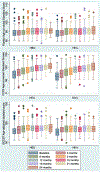Longitudinal Cognitive Outcomes in Children With HIV in Zambia: 2-Year Outcomes From the HIV-Associated Neurocognitive Disorders in Zambia (HANDZ) Study
- PMID: 36094489
- PMCID: PMC9480865
- DOI: 10.1097/QAI.0000000000003052
Longitudinal Cognitive Outcomes in Children With HIV in Zambia: 2-Year Outcomes From the HIV-Associated Neurocognitive Disorders in Zambia (HANDZ) Study
Abstract
Objective: To describe longitudinal outcomes and predictors of cognitive outcomes in children with HIV in Zambia.
Background: Multiple studies have shown that children with HIV are at risk for impaired cognition. However, there are limited data on longitudinal cognitive outcomes in children with HIV.
Methods: We conducted a prospective cohort study of 208 perinatally infected children with HIV ages 8-17 years, all treated with antiretroviral therapy, and 208 HIV-exposed uninfected controls. Participants were followed for 2 years. Cognition was assessed with a custom NIH Toolbox Cognition Battery, and tests were combined to generate a Summary Cognition Score (SCS). The contribution of potential risk factors to outcomes was explored using regression models and group-based trajectory modeling.
Results: HIV was strongly associated with lower SCS at baseline [β-14, 95% confidence interval (CI): -20 to -7, P < 0.001]. Change scores over time were similar between groups, but poorer average performance in children with HIV persisted at the 2-year follow-up visit (adjusted β = -11, 95% CI: -22 to -0.3, P = 0.04). Other than HIV, the strongest predictors of baseline SCS included socioeconomic status index (β =3, 95% CI: 1, 5, P = 0.004), history of growth stunting (β=-14, 95% CI: -23 to -6, P = 0.001), history of CD4 count below 200 (β = -19, 95% CI: -35 to -2, P = 0.02), and history of World Health Organization stage 4 disease (β = -10, 95% CI: -19 to -0.2, P = 0.04). In the group-based trajectory model, HIV+ status predicted membership in the lowest performing trajectory group (odds ratio 2.5, 95% CI: 1.2 to 5.1, P = 0.01).
Conclusions: Children with HIV are at risk of poor cognitive outcomes, despite chronic treatment with antiretroviral therapy.
Copyright © 2022 Wolters Kluwer Health, Inc. All rights reserved.
Conflict of interest statement
The authors have no conflicts of interest to disclose.
Figures



Similar articles
-
Socioeconomic Status and Cognitive Function in Children With HIV: Evidence From the HIV-Associated Neurocognitive Disorders in Zambia (HANDZ) Study.J Acquir Immune Defic Syndr. 2022 Jan 1;89(1):56-63. doi: 10.1097/QAI.0000000000002825. J Acquir Immune Defic Syndr. 2022. PMID: 34878435 Free PMC article.
-
Evaluating the Relationship Between Depression and Cognitive Function Among Children and Adolescents with HIV in Zambia.AIDS Behav. 2021 Sep;25(9):2669-2679. doi: 10.1007/s10461-021-03193-0. Epub 2021 Feb 25. AIDS Behav. 2021. PMID: 33630200 Free PMC article.
-
Cerebrovascular Disease in Children Perinatally Infected With Human Immunodeficiency Virus in Zambia.Pediatr Neurol. 2020 Nov;112:14-21. doi: 10.1016/j.pediatrneurol.2020.08.003. Epub 2020 Aug 5. Pediatr Neurol. 2020. PMID: 32871411 Free PMC article.
-
A Meta-Analytic Review of the Effect of Antiretroviral Therapy on Neurocognitive Outcomes in Adults Living with HIV-1 in Low-and Middle-Income Countries.Neuropsychol Rev. 2022 Dec;32(4):828-854. doi: 10.1007/s11065-021-09527-y. Epub 2021 Nov 10. Neuropsychol Rev. 2022. PMID: 34757490 Review.
-
Neurodevelopment in children born to HIV-infected mothers by infection and treatment status.Pediatrics. 2012 Nov;130(5):e1326-44. doi: 10.1542/peds.2012-0405. Epub 2012 Oct 1. Pediatrics. 2012. PMID: 23118140 Review.
Cited by
-
Causes of Pediatric Deaths in Lusaka, Zambia: A Quantitative Geographic Information Systems Approach.medRxiv [Preprint]. 2024 Sep 18:2024.09.17.24313836. doi: 10.1101/2024.09.17.24313836. medRxiv. 2024. PMID: 39371171 Free PMC article. Preprint.
-
Immune Activation Is Associated With Neurocognitive Performance in Ugandan Adolescents Living With HIV.J Acquir Immune Defic Syndr. 2024 Nov 1;97(3):296-304. doi: 10.1097/QAI.0000000000003483. J Acquir Immune Defic Syndr. 2024. PMID: 38902861
-
Neuropsychiatric Outcomes in Children and Adolescents With Perinatally Acquired HIV: A Systematic Review and Meta-Analysis.J Acquir Immune Defic Syndr. 2025 Apr 15;98(5):411-428. doi: 10.1097/QAI.0000000000003595. J Acquir Immune Defic Syndr. 2025. PMID: 39745769 Free PMC article.
-
Early Initiation of Antiretroviral Therapy is Protective Against Seizures in Children With HIV in Zambia: A Prospective Case-Control Study.J Acquir Immune Defic Syndr. 2024 Mar 1;95(3):291-296. doi: 10.1097/QAI.0000000000003357. J Acquir Immune Defic Syndr. 2024. PMID: 38032746 Free PMC article.
-
Central Nervous System Complications of HIV in Children.Curr HIV/AIDS Rep. 2024 Apr;21(2):40-51. doi: 10.1007/s11904-024-00689-x. Epub 2024 Jan 22. Curr HIV/AIDS Rep. 2024. PMID: 38252368 Review. No abstract available.
References
-
- UNAIDS 2021. Global HIV. AIDS statistics—fact sheet Web resource available at https://www.unaids.org/en/resources/fact-sheet. Accessed 4-12-2022.
-
- Danforth K, Granich R, Wiedeman D, Baxi S, Padian N. Global mortality and morbidity of HIV/AIDS Major infectious diseases Washington, DC: The International Bank for Reconstruction and Development/The World Bank. 2017; - PubMed
-
- Health ZMO. Zambia National Health Strategic Plan, 2017–2021 Ministry of Health; 2017.
-
- Bearden DR, Ciccone O, Patel AA. Global Health: Pediatric Neurology. Semin Neurol 2018; 38: 200–207. - PubMed
Publication types
MeSH terms
Grants and funding
LinkOut - more resources
Full Text Sources
Medical
Research Materials

